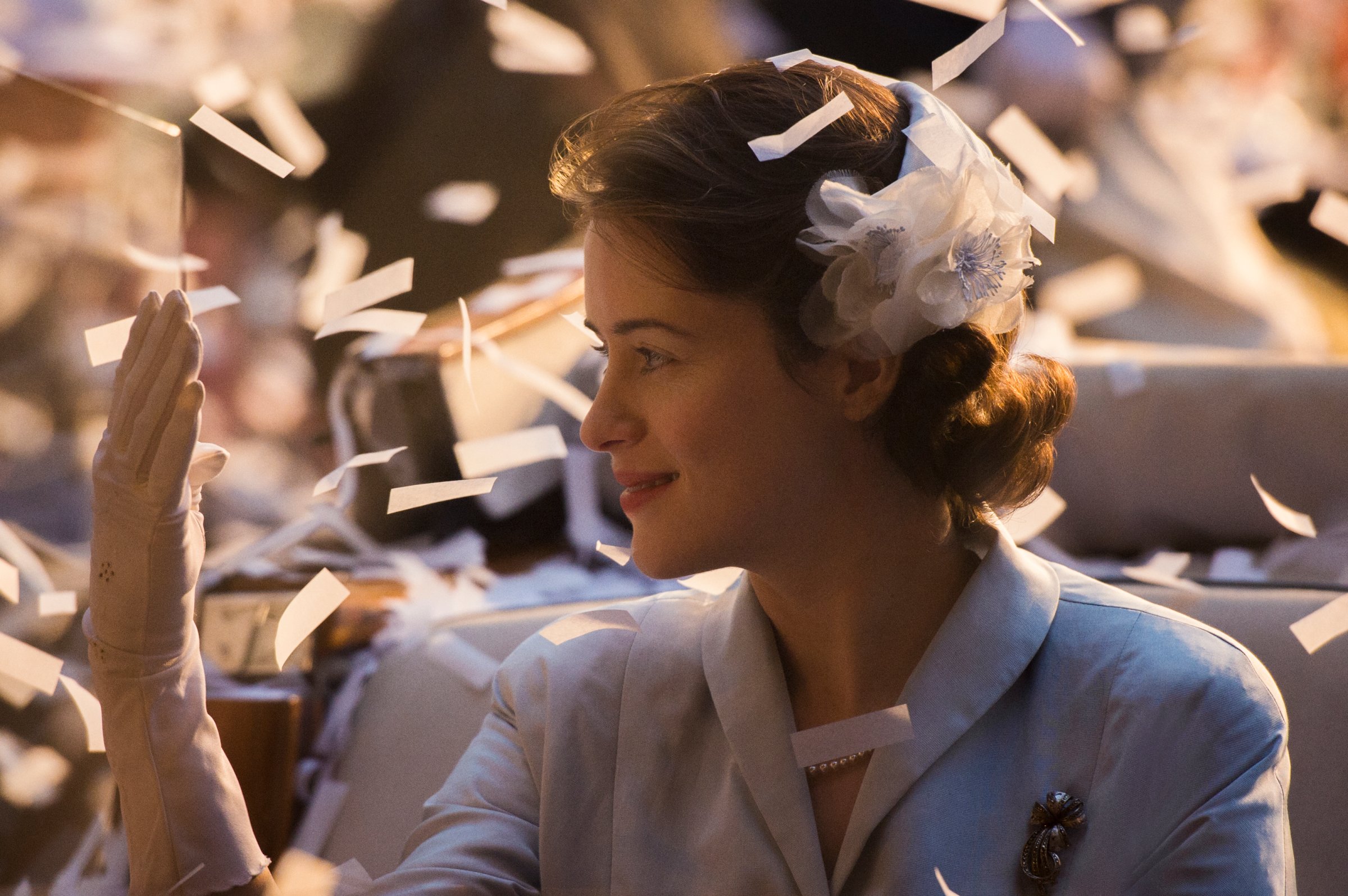
It’s not easy being a queen. Nor is it easy to play one. To re-create the coronation of Queen Elizabeth II for Netflix’s new series The Crown, premiering on Nov. 4, actor Claire Foy had to don a corset, five underskirts, a 5-lb. crown and a replica of the real dress the Queen wore on that historic day. The show borrowed the garment from an exhibition. “There was a lot to carry, costume-wise and crown-wise and scepter-wise,” Foy tells TIME. “The dress was too long. We couldn’t take it up, so underneath I had on these skyscraper platforms that were white, pink and teal, which is not very queenly.”
The Crown is nothing if not ambitious. Created by Peter Morgan, it aims to span six 10-episode seasons, one for each decade of the monarch’s ongoing reign. Netflix has reportedly spent £100 million on the production. The first season required more than 7,000 extras, and 100 people worked on the costumes alone. Morgan hired seven researchers to help him dig through a trove of films, books, articles and photographs.
Given the global interest in all things royal–weddings, babies, scandals–The Crown is a clear bid by Netflix to attract an international audience for its streaming service. But as Morgan’s credentials suggest, the show aspires to be more than a costume drama that will scratch the same itch that Downton Abbey did for Anglophiles.
Morgan, who also wrote the screenplays for The Last King of Scotland and Frost/Nixon, has spent the past decade creating fictional versions of Elizabeth: he wrote the 2006 film The Queen, for which Helen Mirren won an Oscar, and the 2013 play The Audience, for which Mirren won a Tony.
No one is more surprised by this turn of events than the writer himself. “If you’d have said this to me 10 years ago, I would have laughed. I would have said I can’t think of anything I want to write about less,” Morgan says. “But she’s a fantastic prism through which to look at the second half of the 20th century.”
Queen Elizabeth II ascended to the throne when she was just 25 years old, after the unexpected death of her father King George VI at age 56. (In the first episode of The Crown, we see the King’s doctors initially hide from him their diagnosis of terminal cancer.) Elizabeth was forced to make the overwhelming transition from her planned life as wife and mother to monarch decades earlier than she’d imagined. Although her later years have been extensively documented in photographs and film, there’s little to draw from in her earliest days on the throne, leaving Foy to invent much of the character.
Foy has some experience imitating royals: she is best known for playing a much less lucky Queen, Anne Boleyn, in the BBC’s Wolf Hall. But Elizabeth has a stiffer upper lip than the spoiled, ambitious and desperate Anne. In character, Foy does not allow her emotions to bubble above the surface. Anxiety and sadness flicker across her face as she maintains her proper posture. “You never really know how she feels,” Foy says of Elizabeth. “There’s no massive breakdown scene where she starts smashing things. It’s all very hidden. I can’t imagine how lonely it all must have been.”
Elizabeth’s new title means giving up much of what she personally might have wanted. “There is a constant duality between who you are as an individual and what the crown makes you become,” says Morgan. “With the crown comes a series of rules and expectations that might be quite out of step with the person who has the crown on her head.”
It also means alienating friends and family. Elizabeth’s coronation kicks off conflicts with her uncle and sister as well as Prime Minister Winston Churchill, played by John Lithgow as a hero struggling to maintain power in old age. But the divide between personal happiness and political obligation is most clear in Elizabeth’s relationship with her husband Prince Philip, played by Matt Smith, who portrayed the 11th BBC incarnation of Doctor Who. At times, Philip is aggressively unlikable, especially when judged through a modern lens. He makes racist jokes on a royal excursion to Kenya and plots his own climb up the social ladder at his spouse’s expense. He bristles under Elizabeth’s newfound power, beginning with the moment he’s told by advisers that he must walk behind her.
Yet Morgan, Foy and Smith find a way to humanize the prince. “I think Matt and I both fell in love with Philip in a way,” Foy says. “He became sort of superfluous, but his life changed as much as hers did. He had to sacrifice so much of his career for her. And this is a man who was basically an orphan.”
While Elizabeth is the hero of the show, the series doesn’t shy away from scandals, like Princess Margaret’s affair with a married man. So far, Buckingham Palace has remained mum on the show prior to its premiere. “There is no collusion. I want to be independent of them. I want them to be independent of us,” Morgan says. “I wouldn’t want to know if any of them had seen it.”
More Must-Reads from TIME
- How Donald Trump Won
- The Best Inventions of 2024
- Why Sleep Is the Key to Living Longer
- Robert Zemeckis Just Wants to Move You
- How to Break 8 Toxic Communication Habits
- Nicola Coughlan Bet on Herself—And Won
- Why Vinegar Is So Good for You
- Meet TIME's Newest Class of Next Generation Leaders
Write to Eliana Dockterman at eliana.dockterman@time.com